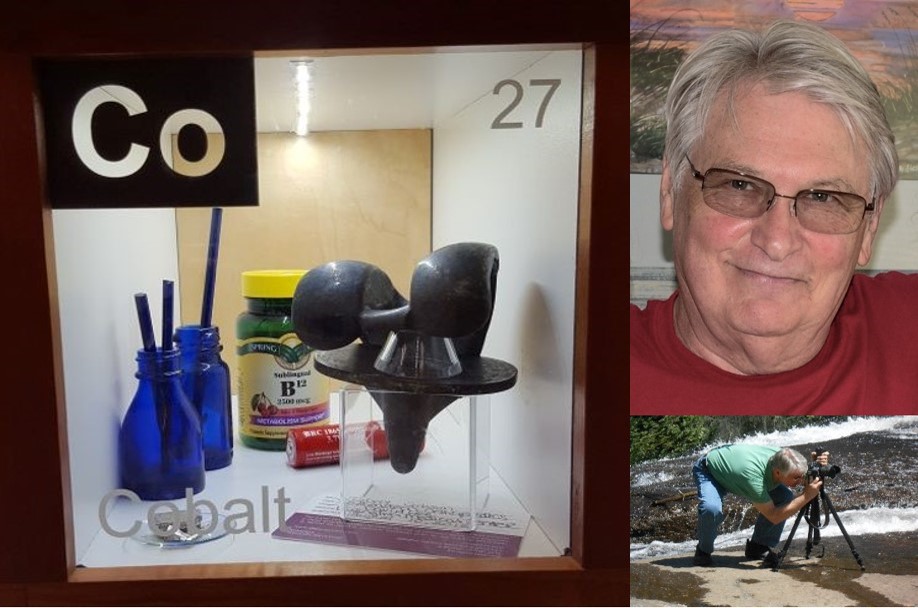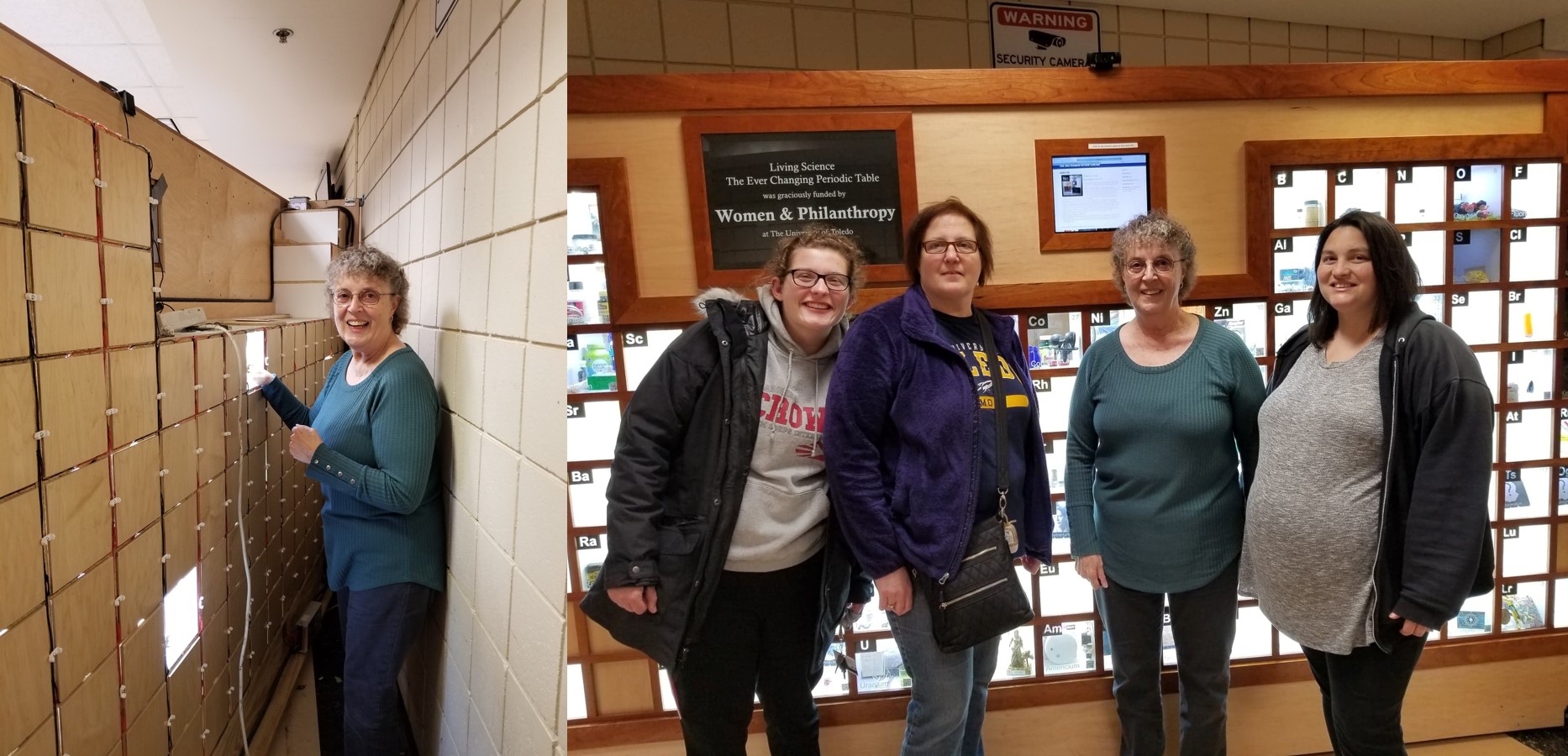Cobalt

This Cobalt Periodic Table of Elements exhibit is being donated in honor of Robert (Robt) Edward Gibson, a most amazing and compassionate man. Born to Clarence and Nellie Griffith Gibson, he began his earthly adventure loudly on April 19, 1951 at Columbia Hospital in Columbia, SC and ended it quietly at home on August 13, 2016 following a five month fight against multiple, highly unstoppable cancers. Upon his death, his body was donated to the USC Gift of Body Program, Cell Biology & Anatomy, USC School of Medicine, Columbia, SC to help teach future doctors about the intricacies of the human body. A gift that keeps on giving for every new doctor and the relationship they have with their “first patient”. The USC Program retrieved these knee implant pieces after his death. And today he is being honored with this donation to the University of Toledo’s Living Science – The Ever-Changing Periodic Table.
About the Display: This display features:
- DPS Attune 7R Size 7 Femoral Posterior Stabilized Plate and Size 7 Tibial Base Rotating
Platform. Cobalt-chromium alloys are
 hard, tough, corrosion resistant, bio-compatible metals. Cobalt Chrome is one of
the most widely used metals in joint implant systems. These specific knee pieces
are approximately 64% Cobalt, 27% Chromium, 7% Molybdenum and 6% other elements. Included with the implant pieces is the I.D. card required
for clearance at security metal detection devices. In August, 2015, the DPS Attune
7R Plate and Platform Knee Implant System pieces seen in the Cobalt exhibit box were
implanted in Robt’s right knee on the same day that size 6L versions of both were
implanted in his left knee. After 2 months of intensive physical rehabilitation,
he walked pain free for the final 10 months of his life. His rehab goal was to be
able to walk his granddaughter down the aisle at her Halloween night wedding and to
dance with her – he accomplished both goals. After being bow-legged all his life
and limping on both legs for years, he could finally stand tall – a proud moment!!
hard, tough, corrosion resistant, bio-compatible metals. Cobalt Chrome is one of
the most widely used metals in joint implant systems. These specific knee pieces
are approximately 64% Cobalt, 27% Chromium, 7% Molybdenum and 6% other elements. Included with the implant pieces is the I.D. card required
for clearance at security metal detection devices. In August, 2015, the DPS Attune
7R Plate and Platform Knee Implant System pieces seen in the Cobalt exhibit box were
implanted in Robt’s right knee on the same day that size 6L versions of both were
implanted in his left knee. After 2 months of intensive physical rehabilitation,
he walked pain free for the final 10 months of his life. His rehab goal was to be
able to walk his granddaughter down the aisle at her Halloween night wedding and to
dance with her – he accomplished both goals. After being bow-legged all his life
and limping on both legs for years, he could finally stand tall – a proud moment!! - UltraFire Lithium-Ion Rechargeable Battery, BRC18650, 3.7V, 3000mAh. Cobalt is a key ingredient in lithium-ion batteries, electronics and electrified vehicles. Prices more than doubled in 2017 due to the increased production of batteries. Cobalt and Cobalt compounds are also used for integrated circuits and semi-conductors.
- Two (2) Vintage Cobalt Blue Medicine Bottles. One is imprinted Vicks Va-Tro-Nol (circa 1940s, nose and throat medicine) on the bottom and the other is imprinted Emerson Drug Co. Bromo-Seltzer (circa 1930s, over-the-counter medicine for headaches, upset stomach, hangovers, etc.) at the bottom edge. Some other common medicines that were (and still are) sold in Cobalt Blue bottles are Phillips Milk of Magnesia, Vicks VapoRub and Noxema.
- Three (3) small pieces (10g) of Cobalt 99.9% Metal Samples. In 2017, 69% of the world’s Cobalt was mined as a Copper byproduct and 29% as a Nickel byproduct. It is 32nd in global abundance and the 9th most abundant metal in the Earth’s crust. It is found only in chemically combined form, except for small deposits found in alloys of natural meteoric iron. The free element, produced by reductive smelting, is a hard, lustrous, silver-gray metal.
- Spring Valley Vitamin B12 Bottle. Cobalt is a trace element essential in the maturation of human red blood cells in the form of vitamin B12, the only vitamin known to contain such a heavy element. It is a naturally occurring water soluble vitamin, also known as “cobalamin”. Vitamin B12 cooperates with folic acid (folate) in the synthesis of deoxyribonucleic acid (DNA). A deficiency of either compound leads to disordered production of DNA and to the impaired production of red blood cells. It also has a role in the synthesis of fatty acids in the myelin sheath surrounding nerve cells. A deficiency of this mineral in daily diet can lead to megaloblastic anemia, fatigue, weakness, constipation, loss of appetite and weight loss.
Interesting Facts about Cobalt:
1. The word Cobalt is derived from the German term Kobald, meaning goblin or evil spirit. The original smelting process gave off poisonous
arsenic trioxide (As4O6) that was thought to have been used to replace the silver metal the goblins had stolen.
2. Cobalt is the first metal discovered since prehistoric times.
3. Cobalt is the first metal with a recorded discoverer. Swedish chemist Georg Brandt
(1694-1768) first isolated it in 1735. His research proved that the blue color came
from the Cobalt.
4. Cobalt is not mined in the United States. It is mostly found in the Democratic Republic
of Congo, Zambia, Canada, Russia, Austria, and Cuba.
5. Cobalt is 1 of 3 naturally magnetic metals – the others are iron and nickel.
6. Cobalt-60 is a radioactive isotope and is an import source of gamma-rays, used in
cancer treatments as a tracer, for radiotherapy and to sterilize medical supplies.
7. There are no cities or towns named Cobalt in the United States. But Cobalt, Ontario,
Canada (300 miles north of Toronto) was given its name in 1904 because of the Cobalt/Silver
Rush in the area. Once nearly a ghost town, “Ontario’s Most Historic Town” and the
“Cobalt Mining District” are attracting new attention with the increased interest
in Cobalt production.
In memory of Robert E. Gibson
Robt graduated from Dentsville High School in 1968 and from the University of South
Carolina in 1980 with a BS in Business Administration Management and Marketing, putting
his degree to use at CVS pharmacy stores in Columbia and Wal-Mart stores in Winnsboro
and Ballantine for over 18 years. He also worked for 13 years providing photographic support to the SC DMV. He served in the US Army from 1971 to 1974 in Berlin, Germany and remained in Germany
until 1976 working in the photographic equipment industry.He loved all USC Gamecocks sports, playing his guitar and photographing sunrises/shrimp
boats at the ocean, flowers, old barns, and waterfalls (he couldn’t kneel, so he got
creative). He was privileged to have several local photography exhibits and also taught numerous
Photography classes at Riverbanks Botanical Gardens in Columbia, SC.

| <Previous element-| | |-Onward to the next element!> |
Symbol: Co
Atomic Number: 27
Atomic Mass: 58.933195 u
Electron Configuration: [Ar] 3d74s2
Year Discovered: 1735
Discovered By: Georg Brandt


